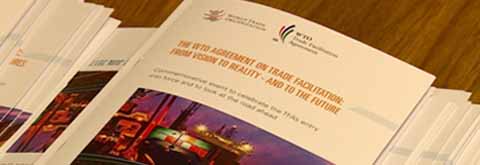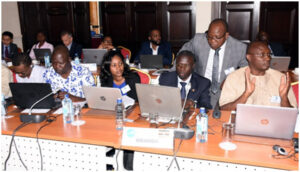The Institute has an exciting array of once-off and regular publications on key development policies, with emphasis on Sub-Saharan Africa. They include Books, African dialogue, research papers, working papers, occasional papers and economic reviews. The Institute’s publications communicate the analysis, views, and scholarship of their authors and are not intended to reflect an official view of the Institute or the views of members of the Institute’s Board of Trustees.
| Title | |
|---|---|
|
Domestic Revenue Mobilization and Reform of the Tax System in Burundi This book explores the link between tax reforms and revenue mobilization, and the options available for policy-makers on revenue mobilization in Burundi. It sets the current system in the context of reforms that have taken place over the last 30 years or so.
|
|
|
Domestic Revenue Mobilization and Reform of the Tax System in Namibia This bookexplores the link between tax reforms and revenue mobilization, and the options available for policy-makers on revenue mobilization in Namibia.It sets the current system in the context of reforms that have taken place over the last 30 years.
|
Download |
|
Taking stock of the tax reforms in Uganda, 1950–2018: Why tax exemptions should be avoided This book traces the tax policy and administrative measures that Uganda government has since introduced and implemented over the past six decades, and explains how the country fared under these reform episodes
|
Download |
|
The rise and fall of budget support in Africa This book provides a critical appraisal of budget support in Uganda since 1998- 2018, highlighting the socio political economy factors for the rise and fall of budget support. It explains why in the past years, support for GBS has diminished significantly among major bilateral donors. While some bilateral donorsreduced their GBS operations, others (formerly dedicated
|
Download |
|
Putting money in a basket with holes: a radical rethinking of the way to finance poverty reduction in Uganda This book explores ways in which donor agencies can avoid the pitfalls of basket funding to impact the lives of the poor in Uganda.
|
Download |
|
Public Expenditure Management Effectiveness in Uganda’s Education System This paper describes how the public education expenditure management system works in Uganda. It specifically identifies the formal roles of institutions; the structure and flow of information generated by the public expenditure management system and applies them to the Education Sector in Uganda. It shows the procedures for each stage in the expenditure and budget
|
Download |
This paper describes how the public education expenditure management system works in Uganda. It specifically identifies the formal roles of institutions; the structure and flow of information generated by the public expenditure management system and applies them to the Education Sector in Uganda. It shows the procedures for each stage in the expenditure and budget process, and indicates how on-going reform processes are modifying the system. Efficient and effective public expenditure management is an essential precondition for government to be able to work towards achieving good education outcomes. The purpose of this chapter is to see whether the public expenditure management system itself could be improved to lead to a better and more effective use of public resources on education. The reform in the budgetary process placed considerable pressure on the education sector and the district local government to improve operational skills in the areas of financial management, planning, monitoring and implementation. UPE is therefore, faced with a number of challenges, which include lack of (technical) capacity at the district level to cope with the new budgetary system; delays in release of funds that have constrained revenue utilization in the districts. Poor rate of absorption (performance) of UPE funds have affected primary education outcomes in several ways. For example, fewer classrooms that were targeted got built, and fewer teachers than targeted were recruited within planned period of time. |
||
This paper describes how the public education expenditure management system works in Uganda. It specifically identifies the formal roles of institutions; the structure and flow of information generated by the public expenditure management system and applies them to the Education Sector in Uganda. It shows the procedures for each stage in the expenditure and budget process, and indicates how on-going reform processes are modifying the system. Efficient and effective public expenditure management is an essential precondition for government to be able to work towards achieving good education outcomes. The purpose of this chapter is to see whether the public expenditure management system itself could be improved to lead to a better and more effective use of public resources on education. The reform in the budgetary process placed considerable pressure on the education sector and the district local government to improve operational skills in the areas of financial management, planning, monitoring and implementation. UPE is therefore, faced with a number of challenges, which include lack of (technical) capacity at the district level to cope with the new budgetary system; delays in release of funds that have constrained revenue utilization in the districts. Poor rate of absorption (performance) of UPE funds have affected primary education outcomes in several ways. For example, fewer classrooms that were targeted got built, and fewer teachers than targeted were recruited within planned period of time. |
||
In this paper,we document the experience with donor funded projects in Uganda, identifying both factors that contributed to its success and that hindered its effectiveness. We find problem of low/slow disbursement to be associated with funds procedures and conditions attached to specific projects, including the counter-part funding requirement; conditions for aid effectiveness; deficiencies in procurement planning and failure to follow the conditionality and funding guidelines on procurement procedures. The ranking of these problems do vary from project to project.The weak project implementation capacity (capacity constraints) implies that attention needs to be focused on building capacity of technical staff especially in those projects with elaborate procedures such as the World Bank IDA/IBRD projects. |
||
This paper examines the stance of fiscal policy in Swaziland since the 1980s, and the attempts that have been made to restrain the excessive deficits that have built up over the past 15 years. Swaziland’s fiscal difficulties have arisen in part from two decades of slow growth, and falling revenue from SACU’s revenue sharing pool, aggravated by the collapse of the fiscal discipline. It would be easier to reduce fiscal deficit and stabilise debt burdens if growth were to pick up and the tax system restructured. But growth alone or expanding the revenue sources per se won’t resolve the problems. Bold actions to rationalize government expenditures and strengthen mechanism for public debt management are essential for the needed adjustment. The fiscal adjustment road map, if firmly implemented, could bring the deficit down to a sustainable level and reduce dependence on SACU transfers, and government debt would remain sustainable over the medium term. However, policy inaction would be a sure recipe for deeper crisis as the overall fiscal balance would remain above 14.5 percent over the medium term and debt to GDP ratio would rise to unsustainable levels (over the medium term). |
||
This paper provides a situation analysis of the current investment and employment in agriculture and rural Uganda aimed at providing appropriate policy recommendations for increased and sustained economic development in the rural sector. It assesses the employment implications of Uganda’s economic growth and investments as a basis for defining operational national action programs, and interventions for poverty reduction. It finds that, despite effort to reduce policy induced distortions in agriculture under the Economic Recovery and Structural Adjustment Programmes (ERSAP) of the late 1980s and early 1990s, overall investment in agriculture has remained very low due to, among other factors, absence of incentive framework for potential rural investors, poor access to land, low productivity and low return to factors of production, lack of capital, particularly, at the farm level, poor access to markets and poor infrastructure, and effects of HIV/AIDS |
||
The paper finds no substitute for property rights and gender-balanced policies as precursors for greatly reduced poverty, hunger, and general suffering. It equally holds in doubt the ability of any organization, world or national, religious or secular, to accomplish as much in the absence of those basic and gender-balanced rights. Women’s predominant role in agriculture and family welfare and close interaction with the environment means that there are potential repercussions for Africa food sector and the environment in light of diminished rights to productive resources faced by women farmers. Policy that can accord women access and security to tenure, and improved access to market, education (particularly education of girls) and health while ensuring macroeconomic stability would be a win-win-win situation because it could lead to more growth, less poverty and improved resource management. |
||
This paper maps out the roles and participation of key institutions and actors in anti-corruption campaign, and explores the various reform initiatives that have been implemented by Government as well as the ongoing and planned interventions in the fight against corruption. |
||
The paper analyses the impact of corruption on cost of doing business in Uganda using a survey data of 100 firms – comprising manufacturers (textile, and beverages/soft drinks); exporters (coffee traders and processors, and textile firms); and importers (textiles, and computer dealers, among others) and finds persistence level of corruption manifested in form of bribery, evasion of taxes and discrimination in the application of regulations and in the provision of services. |
||
One of the major objectives of UPE and education public spending is equity.One of the major objectives of UPE and education public spending is equity. This paper assesses how equitable Uganda public education expenditure really is – how the public education expenditure differs across the districts and regions and how this has changed over time. It explores the costs facing households in sending their children to school - how these costs relate to government spending per pupil and how they have changed over time. It finds that despite universal primary education, parents with children in government-aided schools still spend more money in sending and keeping their children in schools that contribution by government taken together. They spend on uniform; transport; exercise books, pens, pencils and rubber; meals; and medicare, among others. These roles are not different from what parents had before UPE, except that they are now exempted from payment tuition. Results also show a wide disparity in resource allocation in per pupil term, across to districts, and these differences in expenditures across the districts have been on increasing trajectory over the years. |
||
The origin of the drive for UPE dates far back after independence in 1963, with appointment of the Castle Commission – the first education policy review. It continued with subsequent governments up to the NRM Government, which implemented it in January 1997, following an election promise. This paper takes the reader through this journey. |










